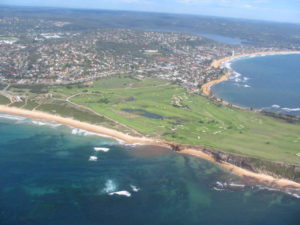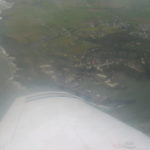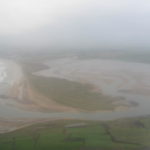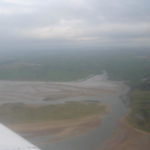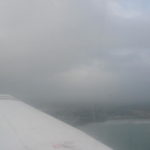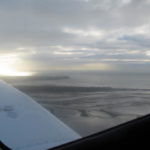 So the big day has arrived once again and finally the weather is good enough to fly. I got to Tradewinds about 11:30am, got the DUAT weather briefing and spent about an hour completing the flight plan to Paso Robles. The weather was forecast clear all the way down the coast with visibilities greater than 6 miles and just broken clouds at between 12,000’ & 20,000’. There was a SIGMET for turbulence south of Salinas and a PIREP over Salinas stating no turbulence found. The only excitement was taking care of my solo endorsement. I realized during the week that the 90 days had expired at the start of January. I emailed Grainne during the week to ask her could she be at Tradewinds to sign another one or set up another CFI to do it. I wasn’t too worried because I figured she would be there anyway. About 1:30pm I called her and found out that she hadn’t checked her email and wasn‘t due into Tradewinds until about 4pm. Luckily, Yoed showed up shortly afterwards and gave me the endorsement, I’ve flown with him several times, and flew with him just two weeks ago, so he was happy to sign me off.
So the big day has arrived once again and finally the weather is good enough to fly. I got to Tradewinds about 11:30am, got the DUAT weather briefing and spent about an hour completing the flight plan to Paso Robles. The weather was forecast clear all the way down the coast with visibilities greater than 6 miles and just broken clouds at between 12,000’ & 20,000’. There was a SIGMET for turbulence south of Salinas and a PIREP over Salinas stating no turbulence found. The only excitement was taking care of my solo endorsement. I realized during the week that the 90 days had expired at the start of January. I emailed Grainne during the week to ask her could she be at Tradewinds to sign another one or set up another CFI to do it. I wasn’t too worried because I figured she would be there anyway. About 1:30pm I called her and found out that she hadn’t checked her email and wasn‘t due into Tradewinds until about 4pm. Luckily, Yoed showed up shortly afterwards and gave me the endorsement, I’ve flown with him several times, and flew with him just two weeks ago, so he was happy to sign me off.
Mike Shiflett, the Designated Examiner turned up a little late about 2:20pm and we got straight down to checking the maintenance logs for 4754D. We had already established that I knew where to find everything when I completed the oral last December so he just checked it himself. Then Mike checked my solo endorsement, thankfully that was now in order. Mike briefed me on what we would do, first the three possible outcomes, pass, fail or discontinue. He said that we would try and get the landings done in the pattern at RHV traffic permitting. Then depart on the cross-country, once he’d established I could fly a heading and was going in the right direction, he’d give me a diversion. On the way we would do the air work, steep turns, slow flight and stalls. Then go enter a pattern somewhere and complete any of the landings we hadn’t got done at RHV and finally do some hood work on the way back including two unusual attitude recoveries. Then he sent me out to pre-flight and told me he’d meet me in the plane in 15 minutes.
The pre-flight was fine. Mike turned up and we ran through the inside checklist. He’d already told me to skip the briefing, but I pointed out when I would have given it anyway. My troubles began with the taxi instructions from ground control. Ground gave me some kind of a preamble which I didn’t catch. He appeared to say “…. after Dakota…taxi via Zulu to 31R”, I thought he was referring to a plane already on Zulu and telling me to wait for it before taxing. I confirmed this back and everything seemed ok. I pulled out checked my brakes, asked Mike to check his and turned onto Zulu. Just as I was turning Mike called Ground Control and said “Was that that for us?”, there was a reply which I didn’t quite catch and Mike told me to turn onto Echo and taxi via Yankee to 31R. So I did, but I really wasn’t sure what I had missed in the whole exchange. Had I totally misheard the Ground Control instructions? what had just happened? I decided to put it out of my mind and not explore the whole thing with Mike as we taxied down Yankee. The run up was fine and Mike told me to make a short field takeoff. This went fine, though the speed control transitioning from Vx to Vy was a little sloppy. I turned crosswind then downwind in right traffic. Mike told me to make a soft field landing. I ran through the pre-landing checklist, got my clearance to land, turned base then final and made a fairly good soft field landing. We did a touch and go with Mike taking care of the flaps. Second time around Mike called the Tower and told them we would do short approach just after I got my clearance to land. He’d told me he would do this for the emergency landing, so I took my hand of the throttle and let him pull it back to idle. I established best glide, told him I wasn’t going to perform any cockpit checks, instead I was just going to “fly the plane”, however, I said I’d secure the engine (fuel off, mixture at cutoff and magnetos off) in case of a mishap on landing. I didn’t put any flaps in, and we were high coming over Eastridge Mall. He commented on this and I told him my aiming point was taxiway Bravo about one third of the way along the runway. Our glide-slope for this point was reasonable and I‘d have made it without problems. Over the numbers he told me to go around, which went well. Back on downwind again he told me to make a short field landing between the VASI lights. I turned onto base too soon and pretty much realized my mistake right away. Turning to final it was clear there was no chance of making the touch down point so I called the Tower and said I was going around. There was another plane rolling on 31R so the tower told me to fly left of the runway. As we climbed up my airspeed was high and I got a little pre-occupied with this. I forgot to take out the last 10 degrees of flaps which Mike reminded me of as we got to about 900’. I got back to pattern altitude and this time the short field landing went ok, but I had to add quite a burst of power to just make my touch down inside the first VASI light, not the best short field I ever done. Mike told me to exit at taxiway Charlie, I did, turned onto Yankee, stopped and did the after landing checklist. Then I was about to start taxing down to 31R again when Mike said “Are you going to taxi without a clearance”. I said no, and called the Tower to ask for clearance to taxi to 31R. It took three attempts to get the Tower to reply, finally they did and got somewhat tongue-tied explaining that they couldn’t see us on Yankee with the rows of parked planes in the background. On the way down Yankee I requested a downwind departure and the Tower asked me if left downwind was ok, which it was. Mike asked for a soft-field takeoff. So I put in 10 degrees of flaps and did the usual soft-field taxing with the nose high not using any brakes to turn. We were cleared to cross 31R and takeoff on 31L. The actual takeoff was poor, I’m not sure I really got into ground effect well and we wandered a bit on the runway. On the climb up I realized I’d forgotten the pre-takeoff checklist and so I quickly put on my landing light and transponder. I also hadn’t actually written down the takeoff time, though I’d noted it in my head and I wrote it down when we got onto the downwind leg. This was also when I realized that I hadn’t brought a watch with me and that the clock in the plane was firstly showing Zulu time and even so was totally wrong.
I did the normal climb checklist, did some shallow turns to check for traffic and pitched for 80 KIAS to get a little better visibility over the nose. Then I started playing with the heading indicator, I was flying towards South County, but the heading didn’t seem to match my calculated heading which would send me in the wrong direction into SJC class C airspace. Mike asked me what my first checkpoint was, so I told him top of climb at 5500’ about 4 miles before South County. He told me to level off at 3500’ head for Lake Anderson, then to do a diversion to Watsonville. This actually gave me some time to work on the charts before I got to the Lake, for once my altitude was bang on 3500’ and staying put. However, I managed to completely waste this time, by measuring a heading from Lake Coyote. I realized my mistake as soon as I turned onto the heading. So I started a wide easy circle over Anderson trying to work out the correct heading. Now its hard enough to struggle with charts and plotter flying straight and level, its even harder to do it flying a circle. In addition the lake falls right on a fold in the chart so you need to have it unfolded and there just didn’t seem to be any convenient lines of latitude or longitude to use to measure the heading. It seemed to take forever to make the measurement. When I finally turned onto the heading I made the mistake of not checking I was clear before I turned. I could see Mike somewhat energetically looking out the window to check for traffic. He didn’t comment so I didn’t either.
I passed to the north of South County and Mike told me to setup for steep turns. I did a couple of clearing turns, slowed to 95 KIAS and ran through my maneuvering checklist. Then did a turn to the left. It was terrible, I lost 300’ of altitude and way over-banked the plane. Mike claimed I reached 70 degrees of bank, I didn’t believe this but I wasn’t going to argue with him. I then did a turn to the right which was a little better, but still lost about 100’. He told me to do another to the left and this one was almost as bad as the first. I just couldn’t seem to understand what I was doing wrong, as I was coming round in the turn I could see my altitude start to drop, I added some more back pressure and tried to keep the bank angle at 45 degrees, but I still felt the G increasing and lost even more altitude. Mike asked me how I’d been taught to do steep turns, I said with reference to the horizon. He told me I was spending too much time looking at the instruments and not looking outside. He said show me two more turns to standard and I could just feel the test slipping away from me. So I did another turn to the left, same problem and I thought well that has blown it. Then he asked did I want to see how a steep turn was done, so I said yes. He then performed a turn left and right that were flawless. With that he took out some Postit Notes and covered all the instruments and told me to try it once more without the instruments. So I glued my eyes on the horizon and tried one last time. I think the turns were a little better, but as the altimeter was covered I couldn’t see if I made the standard or not. Mike told me make a couple more clearing turns which got us flying back towards South County. So as he hadn’t ended the test there and then, I figured he’d finally given me the benefit of the doubt. It bugs me, but I’ve flown perfect steeps turns so many times, and the first time it really matters I screw them up so badly. I know, that as I increased the back pressure that the bank angle would steepen, but I tried to account for that keeping the plane at 45 degrees to the horizon.
Mike told me to setup for slow flight, full flaps at 50 KIAS. This went well, I got slowed down without losing any altitude. Then he had me make a couple of turns to headings left and right. I was somewhat rattled by the steep turns and my rudder coordination just went to hell. I was using aileron to compensate for the left turning tendency and I overshoot the heading on the left turn by quite a bit. Still, the speed and altitude control was reasonable. Then he told me to do a power-off stall, I asked if I should do it from the current configuration and he said just pull the power to idle and do the stall and recover to Vy. I did, and remembered to call the buffet and stall break (the stall horn was already blowing), the recovery was just fine. I guess because the power-off stall went so well he didn’t ask me to do a power-on stall (whatever the reason I was happy).
Then he told me to head for South County and enter the pattern. This went pretty well. Nobody answered when I asked for a traffic advisory. So I over flew the field at about 2500’. I saw one plane on the downwind leg for 32 and announced I was going to enter on the right 45 for 32. The pattern entry was great, right at 1300’ (correct altitude) on the 45 and turned to downwind. There was a reasonable wind blowing so I had to crab a little on base. There was just a minor crosswind so I did just a very gentle side slip on final, keeping lined up with the runway. The normal landing was fine, the only thing I forgot was to add in the crosswind correction as we did the rollout. We did a touch and go and then departed back towards UTC (the usual call in point for RHV coming from the south).
Mike had me put on the hood as we climbed. He asked for a constant speed climb at 80 KIAS, with a couple of turns to headings on the way up then to level off at 3000’. No problems with any of this. Then he took the plane and put it into some unusual attitudes. The first was a dive to the right, I was a little slow to get the power off, but I remembered to do that, level the wings before pulling the nose out of the dive. The second was an almost stall, pitched up to the right. I got in full power and then back to straight and level. Again no problems. He told me to take off the hood and he took control of the plane while I got the ATIS for RHV. The haze was really bad over UTC (about 9 miles out) I couldn’t even see Lake Cunningham (which is a big lake right next to the airport). Mike told me to make a normal landing at RHV. I called the Tower and was given straight in to 31L, report 3 miles. So I started my descent, got through the checklists. The Tower warned me of some traffic on the way in, but it was another of those complicated calls where I wasn’t quite sure where to look for the traffic. I called back saying I was looking, there was a plane at about my 2 O’clock position, so I called the Tower and asked them to confirm that was the traffic, they said it was. Just as I was about to report in, I got my landing clearance. Here was another of those “well I was told to report at 3 miles, but I already have a clearance so do I really need to?”. Normally I’d say no the whole point of reporting in is to get the clearance, but with Mike in the plane and after the issue with the taxi clearance on Yankee I thought I’d explain why I wasn’t going to report the 3 mile point. The actual landing was just fine and there were no surprises on the taxi back to park the plane.
Mike told me to get the plane secured and that he’d meet me back in the briefing room. As I got out of the plane Grainne was just pulling out in another plane with one of her other students. I gave her a thumbs-up coupled with a shrug. I figured that as Mike had let me fly the plane back to RHV and hadn’t stopped the checkride that I must have passed, but he hadn’t said anything getting out of the plane. I felt that my flying had been so marginal that I wasn’t really sure I’d passed. Back in the briefing room I had a long discussion (one sided Mike did all the talking). He told me that I was banking too much in the pattern (I‘ve heard that before). That I turned the radio down too far on takeoff, so that I might not have been able to hear the Tower over the engine. That I forgot the crosswind correction in South County (i.e. keep flying the plane every second, don’t stop just because the wheels are on the ground). We had a long chat about radio procedures and how, while you might assume something in RHV because that is the way its always done here, it was an exception to the rules and that assumption would get you into real trouble at other airports. Finally, he handed me my Temporary Airman Certificate and asked for my log book in which he logged the 1.5 hours PIC. I had passed!
I can’t really say the checkride was a positive experience. It was really stressful. I felt I flew badly, made some dumb mistakes and in general came away feeling like I’d only just made it by the skin of my teeth. I am a bit pissed at myself because I know I can fly far better than I demonstrated today that has definitely taken away some of the elation I expected to feel on passing the test. Still, the PPL is just the starting point. This checkride is just the first of many. I had already resolved to stay training until I climb out of the first 250 hours danger mark. So I’ll take a little rest do some flying for fun and then its time to start on the IFR rating.










